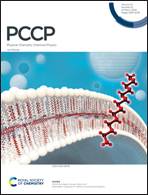A simple scheme for finding magnetic aromatic hydrocarbon molecules†
Abstract
Polycyclic aromatic hydrocarbon (PAH) molecules such as quasi-unidimensional oligo-acene and fused azulene display interesting properties for increasing chain length. However, these molecules can be hard to explore computationally due to the number of atoms involved and the fast-increasing numerical cost when using many-body methods. The identification of magnetic PAH molecules is most relevant for technological applications and hence it would be of particular interest to develop rapid preliminary checks to identify likely candidates for both theoretical and experimental pursuits. In this article, we show that an analysis based on a second-order perturbation treatment of electronic correlations for the Hubbard model qualitatively predicts the outcome of more extensive and accurate methods. Based on these results we propose a simple computational protocol for screening molecules and identifying those worthy of a more sophisticated analysis on the magnetic nature of their ground states. Using this protocol we were able to identify two new magnetic molecules made from the combination of only two naphthalene monomers and two azulene ones (both isomers with formula C34H20). For further confirmation of this result, these molecules were also studied by means of density matrix renormalization group and density functional theory.



 Please wait while we load your content...
Please wait while we load your content...